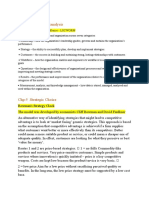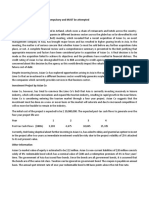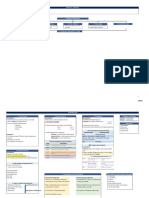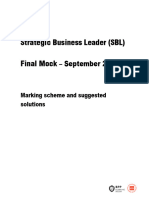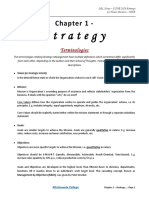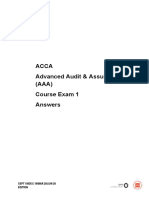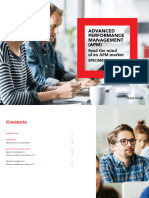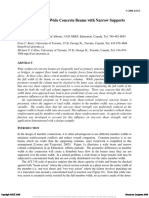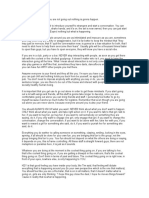Answers
Strategic Professional – Essentials, Marking Insight Mock Exam
Strategic Business Leader 2018 Answers
Note
It is not always possible to publish suggested answers which comprehensively cover all the valid points which candidates might
make. Credit will be given to candidates for points not included in the suggested answers, but which, nevertheless, are relevant to
the requirements.
In addition, in this integrated case study examination points made in one question may be re-introduced or fully developed in other
question(s) as long as these are made in the specific context of the requirements of the part of the question being answered.
The suggested answers presented below may give much more detail than would be expected from most candidates under examination
conditions; they may also have used a particular approach or model which should not be taken as the only approach or model which
could have been used. Different approaches and structuring of the answers are expected and full credit will be given for relevant and
appropriate solutions to the tasks given. The answers provided here are therefore intended to support revision and tuition for future
examinations.
Finally, it should be noted that candidates will not get full professional skills marks in a task requirement if they have not presented
their answers according to the format asked for. For example, if a task is to be completed using a report and evaluation skills are
tested, even if the answer has met the specifically stated evaluation criteria, candidates will not be able to earn all the professional
skills marks available if they have not used the report format.
1 Acquisition of FRG
To: The board, MachineShop
From: Moore & Charlton, Chartered Accountants
Date: April 2018
Report on the acquisition of Fabrique Regle de Garrido (FRG)
Introduction
This report looks at the potential acquisition of FRG by MachineShop. It uses the criteria of suitability, acceptability and feasibility,
which is a standard framework for evaluating potential acquisitions. It concludes with my recommendation.
Suitability
Suitability is concerned with whether a strategy addresses the circumstances in which an organisation is operating, the strategic
position. In the context of MachineShop, does an acquisition make sense and, in the narrower context, does the acquisition of FRG
make sense?
An acquisition makes particular sense if speed to market is vital. This appears to be the case at MachineShop, where the board
wants the company to grow quickly whilst there are no direct competitors.
In terms of capabilities, the delivery of economies of scale is also important and this has already been identified as a key benefit of
the acquisition, further raising a barrier to entry to potential competitors.
Finally, in terms of growth, acquisition appears to largely avoid the cultural problems which are bound to arise by trying to organically
grow a company in a foreign land. Expansion in Ceeland is seen as an opportunity for rapid growth, exploiting important strengths,
in particular, the internal competencies of MachineShop. Acquisition, particularly in Ceeland, appears to offer the rapid growth
which the company seeks.
It should be noted that MachineShop has no experience of acquiring a foreign company.
Acceptability
Acceptability is concerned with the expected outcomes of a strategy. These can be seen in context of stakeholder reactions, risk and
return.
In the context of MachineShop, the primary stakeholders, the board, are likely to be excited by a foreign acquisition. It provides you
with the high profile and the business excitement which you enjoy.
However, in financial performance, the potential purchase of FRG looks less attractive. Any financial ratios calculated for FRG cannot
really be compared with MachineShop, because the nature of the customers is quite different, with 65% of MachineShop’s sales
being made to retail consumers. The country and culture of the two companies is also different. However, whilst acknowledging this
limitation, an analysis of the latest financial figures (Table 1) does not appear to paint a particularly attractive picture. FRG has gross
profit and operating margins well below that of MachineShop. FRG also has a relatively low return on capital employed (ROCE) of
6·45%, compared to 17·5% for MachineShop. The gearing ratio is higher (20·16%) and the interest cover is lower (2·67) than
MachineShop.
15
� Table 1: Comparison of MachineShop and FRG
Calculation MachineShop FRG
Gross profit margin Gross profit ÷ Revenue 28·00% 16·67%
Operating margin Operating profit ÷ Revenue 16·00% 8·89%
ROCE Operating profit ÷ Capital employed 17·50% 6·45%
Gearing ratio Long-term loans ÷ Capital employed 15·00% 20·16%
Interest cover ratio Operating profit ÷ Finance charges 16 times 2·67
Improving the financial performance of FRG might be seen as an opportunity for MachineShop.
Feasibility
Feasibility is concerned with whether an organisation has the resources and competencies to deliver a strategy. No negotiations
have yet been opened with FRG. As a result, no comment on the financial feasibility of the acquisition can be made. However, the
difficulty of satisfactorily valuing a private company suggests that many months of negotiation might lie ahead, particularly given
the number and composition of the shareholders of FRG. Trade unions may require certain post-acquisition guarantees about labour
retention and reward. Such protracted negotiations would partly nullify, at least, the speed of growth which acquisition appears to
offer.
Overall, acquisitions have a poor record in delivering business success. There are usually problems of integration and cultural fit.
MachineShop has experienced this to some extent with both LogTrans and EngSup. At LogTrans, the directors had to be removed
post-merger because of personality clashes. At EngSup, there was a problem in instilling in service engineers the need for appropriate
customer service although actions have been taken to improve performance at these two acquisitions.
MachineShop has to review its competencies in acquisitions, not just its competencies in its market. It must also recognise that
both its previous acquisitions took place in Arboria, a country where it understands the culture, laws and regulations. It might be
reasonable to expect that the acquisition of a foreign company would be even less successful.
It also has to be recognised that FRG is not a complete match to MachineShop. FRG is experienced in the business market, but has
no experience of selling to retail customers, a service which accounts for 65% of MachineShop’s sales.
Conclusion
In theory, an acquisition would appear to be a suitable growth strategy given MachineShop’s strategic position and objectives.
However, whether the acquisition of FRG is appropriate is more doubtful. FRG does not appear to be financially performing
particularly well and it has no experience of selling to retail customers. Furthermore, MachineShop has no experience of acquiring
a company outside Arboria.
Overall, the proposed purchase of FRG appears to be very risky and MachineShop might be better looking elsewhere for a more
suitable acquisition. It might also consider entering into a dialogue with FRG about a strategic alliance of some sort (perhaps
followed by acquisition), which might offer an attractive alternative to immediate purchase of the company.
2 Internal audit
Briefing paper
FAO: Viola Wang, CFO, MachineShop
Establishing an internal audit function
The case for establishing an internal audit function has grown in recent years due to MachineShop’s successful expansion of
operations in Arboria. When the company operated a small number of stores, the directors could probably exercise greater control by
monitoring the stores directly. As the number of stores has increased, it is likely to have become more difficult for the directors to do
this. An internal audit function would be able to monitor the larger number of stores by visiting each store periodically and performing
audit and other review procedures to ensure that each store is performing satisfactorily.
There have also been operational difficulties recently as a result of expansion, with some stores experiencing stock outs. An
internal audit function would have the expertise to recommend improvements to the operating systems, including the logistics and
procurement processes which have led to the problems. Internal audit would also be able to make a contribution to Mr Butcher’s
proposal to use more IT, by ensuring that appropriate controls are included within any IT systems developed.
The expansion so far has not resulted in any major change in the complexity of the organisation. Each new store is simply copying
the format and operations of the existing stores. Similarly, there have been not any changes in key risks or changes in external events.
If the company does decide to expand abroad, perhaps through the acquisition of FRG, then the complexity of operations would
increase. While FRG operates in the same industry as MachineShop, there are differences in the way it works, for example, it only
sells to trade customers. There would also be additional risks, such as currency risks and credit risks of selling to trade customers.
Internal audit could ensure that procedures are in place to monitor these risks.
The benefits of greater control must be weighed against the costs of setting up a new function. The largest cost would be the
salaries of the staff who would have to be brought in to perform the function. There would also be additional office costs and costs
of travelling to the various stores, with overnight stays at hotels.
16
� In conclusion, the setting up on an internal audit function now would enable management to monitor the operations of the stores
better, and would help overcome some of the operations difficulties which are being experienced. These advantages would most
likely justify the costs of setting up such a function.
3 Use of IT at MachineShop
(a) Big data
Slide one
What is Big Data?
– Extremely large data sets which may be
analysed to reveal patterns, trends, and
associations relating to human behaviour.
– Characterised by 3Vs:
– Volume
– Variety
– Velocity
– Structured (transactional) data
– Unstructured data
– Nature means traditional methods of storing and
processing data will not work
Accompanying notes
IT systems contain huge volumes of information which can be analysed to identify useful trends. At MachineShop, the sales
system contains records of each individual sale. For many sales, it may be possible to identify information about the customer
to whom each sale is made if the company uses a loyalty card system.
– Volume refers to the huge amount of data, which is unlikely to be stored on a single personal computer;
– Variety means that data may take many different forms – for example, text, structured, unstructured;
– Velocity refers to the speed with which new data arrives.
Structured data is held in defined fields in a system, such as transactional data in the sales system.
Unstructured data may also be used and analysed, such as discussion about MachineShop or its products on social media
sites. Storing and analysing unstructured data is much more difficult, and may involve more human interaction.
Traditional analysis tools may be inadequate for analysis of big data, particularly when it comes to analysing unstructured data.
Slide two
Applications to MachineShop
– Data mining – identifying trends in data
– Predictive analytics
– Text analytics
– Statistical analytics
Accompanying notes
Data mining involves identifying trends in data. It may be possible, for example, to analyse sales by market segment, and this
could be used for more effective marketing messages, or putting together sales bundles whereby buying one product gives the
customer a discount on another product.
Predictive analytics involves using data patterns to predict the future behaviour. At MachineShop, for example, it might be
possible to identify that people who buy tools for heavy building work might later be interested in buying tools for painting and
decorating or gardening. This predictive analysis can be used for direct marketing campaigns which tend to be more successful
than general campaigns.
Text (Social) analytics involves analysing text, typically on social media sites to identify the opinions of participants on those
sites. MachineShop may already have presence on such networks, and may wish to measure the impact which its own
messages are having, in terms of the number of users who read them. Alternatively, the company might wish to know what
users of social media sites are discussing particularly in relation to the products it sells, or its own reputation.
17
� Statistical analysis can identify trends and changes in behaviour. In the case of MachineShop, the company might be interested
in changes in trends relating to people doing their own repairs and maintenance on their homes as this will impact on demand
for its products.
(b) Use of e-procurement at MachineShop
Briefing paper
FAO: MachineShop Board
E-procurement and its potential application at MachineShop
Procurement is concerned with purchasing goods or services for the organisation. It is concerned with sourcing items at the
right price, delivered at the right time, to the right quality, in the right quantity and from the right source.
E-procurement looks at the opportunities presented by automating aspects of procurement to improve the performance of the
‘five rights’ identified above.
In the case of MachineShop, procurement of the goods which it sells in the stores is clearly an essential activity. Currently all
procurement is carried out by a central warehouse, based on requisitions which are sent from each store twice weekly. The
goods are sent to the stores from the central warehouse. Recently, as mentioned by Mr Butcher in the board meeting, there
have been stock outs of several products in the weeks leading up to the December holiday period. Such stock outs not only
lead to the loss of potential sales – they also risk the loss of customers who may be frustrated when the store does not have
the products which they wish to buy.
The re-order levels in the stores, and the inventory held at the central warehouse, which aims to hold two weeks’ worth of
goods, may well be based on average monthly demand, which may not take into account seasonal increases. It is also unclear
how the inventory levels and reorder levels in the store are calculated.
One area of procurement which could be automated would be setting the re-order level. A twice weekly requisition document is
produced automatically by each store, which is sent to the central warehouse. However, this system is based on a pre‑determined
re-order level, which may become inappropriate if sales demand increases. A more advanced system is required which predicts
sales trends more accurately and can therefore predict when inventory levels are falling faster or slower than expected. This
would enable the company to avoid stock outs of popular products, or holding excessive inventory of low selling items.
This system could be improved so that the inventory records in each store are linked to a central system in the central
warehouse so that the central warehouse is immediately aware of when the store’s inventory needs replacing rather than
waiting for the twice weekly requisition document. The central warehouse would then be able to determine if it has sufficient
inventory to meet this or whether it needs to order more from suppliers. This would reduce lead time, thereby further reducing
the risk of stock outs.
Another solution which has been adopted by several retailers is the use of electronic data interchange, whereby orders are
placed automatically with suppliers when inventory levels are running low. Each of MachineShop’s stores could be linked
directly with its suppliers rather than via the central warehouse, with suppliers delivering directly to the stores rather than
through the warehouse. This would not only reduce lead time, but would enable the company to make a large saving on
running a central warehouse and the costs of holding inventory there. It may also enable the company to sell LogTrans, as it
would no longer need to have its own logistics company if suppliers deliver directly to the stores.
Competitive bidding is the practice of posting requirements for goods and services onto the company’s website and asking
potential suppliers to bid. Parts could then be sourced from a number of suppliers depending on price and quality. This may not
be appropriate for the products which MachineShop sells in its stores, as finding reliable suppliers, and building up long-term
relationships with them may be more important than obtaining the lowest price on every order. Competitive bidding could be
used for non-routine products and services, however, such as new computer equipment or consulting services for the business.
Overall, the company could make better use of e-procurement to automate aspects of its business and this may well bring more
reliable supplies and significant savings.
4 Financing options for acquisition of FRG
To: Viola Wang, CFO MachineShop
From: Moore & Charlton, Chartered Accountants
Date: May 2018
Report on financing options for acquisition of FRG
Introduction
This report evaluates the two proposed alternative ways of financing the acquisition of FRG: The issue of a bond of $5 million, paying
7% interest, or the issue of 1 million shares to a venture capitalist for $5 each. In both cases, this would raise $5 million for the
acquisition of FRG.
18
� Issue of bond
The disadvantage of issuing a bond is that MachineShop would be obliged to make annual interest payments to the bondholders.
Pre-tax interest costs would be $350,000 per year. There is a potential risk that should MachineShop’s profits fall steeply, the
company might not be able to afford this interest. This risk is very small, however. MachineShop currently enjoys operating profits
of $8 million and only pays interest of $500,000 on its own debt. Adding the interest on the loan, and even ignoring any dividends
from FRG, MachineShop would still enjoy interest cover of 9·4 times ($8 million ÷ ($500,000 + 350,000)).
An advantage of the debt is that the interest would be tax deductible, leading in a post-tax cost of 5·6% (8% x 80%).
Gearing is currently very low at MachineShop. I have calculated that the consolidated gearing of MachineShop if the loan were taken
out would be 23% (see Appendix). This is higher than the current 15% enjoyed by MachineShop, but still considerably lower than
industry average of 60%. Therefore the loan does not seem to bring about a significant increase in financial risk.
Issue of shares
The alternative to issuing a bond is to issue 1 million shares at a price of $5 per share to a venture capitalist. The advantage of this
is that it avoids increasing the gearing of the company and taking on additional interest – although as discussed above, the effects
of these would not be significant.
The disadvantage is that an outside party would obtain a share of the ownership of MachineShop. Currently, the 10 million shares in
the company are owned by the management. After the issue of 1 million shares, the venture capitalist would own 9% of the shares
in the company (1 million ÷ 11 million).
Venture capitalists would expect to participate in the management of MachineShop. This would include setting financial targets,
and involvement in strategic decisions, and this could potentially lead to conflicts. The current owners, who manage the business,
would discover that they now have to take into account the views of the venture capitalist when making decisions. This may lead to
resentment and conflicts.
Conclusion
Based on the arguments above, I would recommend the issue of debt as a means of financing the acquisition of FRG. This would not
increase the financial risk significantly, and would avoid the directors having to share the decision making with an external venture
capitalist.
Appendix – ratios
Gearing of MachineShop post acquisition of FRG:
$000
MachineShop long-term loans 7,000
Add loan to buy FRG 5,000
FRG loans 2,500
–––––––
Total loans 14,500
–––––––
Equity:
MachineShop 39,000
–––––––
14,500
––––––––––––––––
Total gearing = Debt ÷ Capital employed = = 27%
14,500 + 39,000
5 Letter to CEO
Dave Deen
Chairman and CEO MachineShop
18 June 2018
Dear Dave
Following our conversation, I am writing to you to set out the advantages and disadvantages of you staying on as chairman after a
new CEO is appointed. I will then describe what I believe at the key qualities which a CEO of MachineShop needs to possess.
(a) Staying on as chairman
The primary role of the chairman is to lead the board of directors. Good corporate governance principles advise that the roles
of chairman and chief executive are separated to avoid one person holding too much influence within the company, and this
aim is enhanced if the chairman is an independent non-executive director.
The advantage of you taking over the role of chairman is your experience. As former CEO of MachineShop, you have excellent
knowledge of the company and the market in which it operates. This knowledge would help in the development of the
long‑term strategy of MachineShop and in scrutinising the performance of the executive directors.
There are, however, several disadvantages of you taking on the role. The first is that as a former CEO, people may question
your independence. You will undoubtedly have built up relationships with some of the existing executive directors during your
19
� time as CEO. This may cloud your judgement when participating in the evaluation of these directors. Independence may not
be such an important quality while MachineShop remains a private company, but if venture capitalists become involved, then
they may wish to have in independent chairman.
Another disadvantage of you taking over the role would be the implications for the new CEO. A CEO from outside the company
may have reservations about his predecessor still being involved in the company. He may feel that any changes he wishes to
make would be resisted by the former CEO and that he would not be given a fair opportunity to develop his own ideas.
The respective roles of CEO and chairman would need to be clearly defined. This would be particularly important for you, so
you are clear about what responsibilities you are giving up.
(b) Qualities of a CEO
Regarding the qualities of the CEO, the candidate should have good emotional stability with an ability to work under pressure.
As MachineShop expands, and with the potential acquisition of FRG, the CEO may find he is leading teams who are working
under pressure and emotional stability will ensure that he manages to keep the employees focused in such circumstances.
A good CEO has the ability to admit when he has made errors, and change course where necessary, rather than wasting time
trying to cover up his errors. Mistakes have sometimes been made in the past at MachineShop, and the CEO should have the
ability to admit to these, and do his best to rectify the situation.
Good interpersonal skills are useful, so that the CEO can communicate with staff and get the best out of them.
Intellectual breadth is also useful – being able to understand a broad range of problems will give a CEO the ability to make
well considered decisions. MachineShop is currently considering an acquisition, improvements to its IT systems and internal
controls. A CEO would ultimately be responsible for all of these, so would need to have the aptitude to get to grips with technical
issues in a number of different areas.
Previous industry experience would also be extremely valuable. Understanding the different types of customers within the
building and home improvements industry is essential for ensuring that future strategic decisions are suitable. It would also
ensure that existing staff and directors respect the new CEO and are happy to work with him.
Some writers have discussed transformational skills. A transformational leader has the ability to inspire others, as you yourself
have done. A transformational leader has great vision and is able to communicate this vision to the staff through his own
enthusiasm and passion. This would certainly be appropriate for MachineShop. As the organisation grows and changes, there
may be resistance from some staff who believe that change is bad. A transformational leader will be able to inspire the staff to
support such change and ensure that good service is given to customers.
I hope that this answers your questions. I would, of course, be more than happy to discuss this with you in person should you wish.
Yours sincerely
A Partner
20












